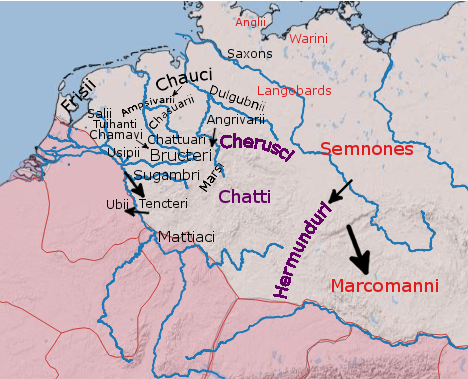Semnones on:
[Wikipedia]
[Google]
[Amazon]
 The Semnones were a Germanic and specifically a
The Semnones were a Germanic and specifically a
 The Semnones were a Germanic and specifically a
The Semnones were a Germanic and specifically a Suebi
file:1st century Germani.png, 300px, The approximate positions of some Germanic peoples reported by Graeco-Roman authors in the 1st century. Suebian peoples in red, and other Irminones in purple.
The Suebi (also spelled Suavi, Suevi or Suebians ...
people, located between the Elbe
The Elbe ( ; ; or ''Elv''; Upper Sorbian, Upper and , ) is one of the major rivers of Central Europe. It rises in the Giant Mountains of the northern Czech Republic before traversing much of Bohemia (western half of the Czech Republic), then Ge ...
and the Oder in the 1st and 2nd centuries AD.
They were described in the late 1st century by Tacitus
Publius Cornelius Tacitus, known simply as Tacitus ( , ; – ), was a Roman historian and politician. Tacitus is widely regarded as one of the greatest Roman historians by modern scholars.
Tacitus’ two major historical works, ''Annals'' ( ...
in his ''Germania
Germania ( ; ), also more specifically called Magna Germania (English: ''Great Germania''), Germania Libera (English: ''Free Germania''), or Germanic Barbaricum to distinguish it from the Roman provinces of Germania Inferior and Germania Superio ...
'':
"The Semnones give themselves out to be the most ancient and renowned branch of the Suebi. Their antiquity is strongly attested by their religion. At a stated period, all the tribes of the same group assemble by their representatives in a grove consecrated by the auguries of their forefathers, and by immemorial associations of terror. Here, having publicly slaughtered a human victim, they celebrate the horrible beginning of their barbarous rite. Reverence also in other ways is paid to the grove. No one enters it except bound with a chain, as an inferior acknowledging the might of the local divinity. If he chance to fall, it is not lawful for him to be lifted up, or to rise to his feet; he must crawl out along the ground. All this superstition implies the belief that from this spot the nation took its origin, that here dwells the supreme and all-ruling deity, to whom all else is subject and obedient. The fortunate lot of the Semnones strengthens this belief; a hundred cantons are in their occupation, and the vastness of their community makes them regard themselves as the head of the Suebic tribe."Tacitus, ''Germania'', Germania.XXXIXThe Semnones's own name is apparently etymologically similar or even the same as the one recorded by Roman authors as "Suebi" and during his own time
Julius Caesar
Gaius Julius Caesar (12 or 13 July 100 BC – 15 March 44 BC) was a Roman general and statesman. A member of the First Triumvirate, Caesar led the Roman armies in the Gallic Wars before defeating his political rival Pompey in Caesar's civil wa ...
, had mentioned Suebi but not Semnones, being a powerful tribal group with 100 cantons.
The king of the Semnones Masyas and his priestess Ganna are mentioned by Cassius Dio
Lucius Cassius Dio (), also known as Dio Cassius ( ), was a Roman historian and senator of maternal Greek origin. He published 80 volumes of the history of ancient Rome, beginning with the arrival of Aeneas in Italy. The volumes documented the ...
. They worshipped a supreme god () at a sacred grove
Sacred groves, sacred woods, or sacred forests are groves of trees that have special religious importance within a particular culture. Sacred groves feature in various cultures throughout the world. These are forest areas that are, for the most ...
. A grove of fetters is also mentioned in the eddic poem '' Helgakviða Hundingsbana II''. Ptolemy
Claudius Ptolemy (; , ; ; – 160s/170s AD) was a Greco-Roman mathematician, astronomer, astrologer, geographer, and music theorist who wrote about a dozen scientific treatises, three of which were important to later Byzantine science, Byzant ...
's map of Germania mentions a forest called Semanus Silva, but a relation to the Semnones is unknown.
In the 3rd century, the Semnones shifted southwards and eventually ended up as part of the Alemanni
The Alemanni or Alamanni were a confederation of Germanic peoples, Germanic tribes
*
*
*
on the Upper Rhine River during the first millennium. First mentioned by Cassius Dio in the context of the campaign of Roman emperor Caracalla of 213 CE ...
people.
See also
*List of ancient Germanic peoples
The list of early Germanic peoples is a catalog of ancient Germanic cultures, tribal groups, and other alliances of Germanic tribes and civilizations from antiquity. This information is derived from various ancient historical sources, beginning in ...
*'' Germania – The Origin and Situation of the Germans''
Notes
{{Authority control Early Germanic peoples Suebi